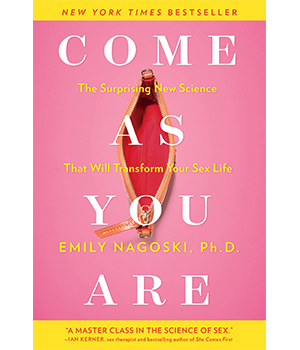Good news, women. According to Emily Nagoski, a Ph.D. in health behavior and self-proclaimed sex nerd, the latest scientific research proves pretty much all of us are sexually normal. That means our libido isn’t too low or too high, our interests aren’t too tame or too kinky, and our wonderful bodies look and function just the way they should. We’re all unique, we all have different appetites and energies and turn-ons, and that wide range of sexual expression is—you got it—normal.

Nagoski is the director of wellness education at Smith College where she teaches women’s sexuality. Her book “Come as You Are: The Surprising New Science That Will Transform Your Sex Life” is the result of 20 years of studying and researching sexuality and the science of sex. Here are some of her findings that will make you feel better and more empowered about your sex life. And, if you want the Cliffs Notes version? The key is to relax!
See your body beautiful.
Feeling badly about your body and the way it looks has a huge impact on your sexuality.
“The self-criticism that women have been trained into since birth is possibly the most destructive aspect of our sexuality that we have some control over,” Nagoski says. “My goal is to give women permission not to beat the sh*t out of themselves.”
Nagoski recommends women spend time in front of the mirror looking approvingly at their bodies—including taking a good look at their genitals. Yep, look at them! It’s the first step to learning about your sexual well-being, and is proven to make you feel better about yourself.
“Touching is great, but if you want to know something about your body part, go look at it,” she says. “Make up your own mind whether it’s beautiful, whether or not it’s a gift to you.”
Desire isn’t just about getting turned on.
It’s also about not getting turned off. This “Dual Control Model” affects desire like the accelerator and brakes of a car, and the interplay between the two systems is unique for each person. Think about it—you may adore a candlelit dinner with your mate, but if you’re feeling overwhelmed by work or rotten about your body, you may not feel all that sexy. Once this dual nature of desire is pointed out, women usually realize the things that trigger them. The most common turn-off is stress, which impacts our bodies in a primal way.
“A bad day has the same stress on a body as being chased by a lion,” Nagoski says. “The single most efficient way to reduce stress is physical activity.”
Any activity—dancing or jumping up and down—communicates you’ve survived the threat and purges the stress chemicals from your body. Once you know what triggers your sexual accelerator and brakes, you can take control of them. Creating the context of pleasure—where you feel relaxed, open, trusting and responsive—is so important, says Nagoski.
Women’s bodies and minds aren’t always aligned.
Have you heard of that study where women’s genitals responded to all sorts of sexual behaviors including copulating primates?
 Guess what? That doesn’t mean women want to have monkey sex. Our bodies don’t always tell the truth about our desire, a term scientists call non-concordance.
Guess what? That doesn’t mean women want to have monkey sex. Our bodies don’t always tell the truth about our desire, a term scientists call non-concordance.
“Women’s genitals respond to any remotely sexual situation,” says Nagoski. “There’s only a 10 percent overlap to wanted sex.”
Increasing blood flow and lubrication can be a response that protects a woman’s body from damage, and it’s not necessarily a sign of desire. On the flip side, a woman can be ravenously enjoying sex and not necessarily get wet. This often confuses men, whose physical and mental readiness are much more consistent.
What signs should a man pay attention to, then, to gauge how turned on his woman is? “Her words!” says Nagoski.
Let go and go slow.
When it comes to satisfying orgasms for women, the less effort the better.
“The way to try is to stop trying,” says Nagoski. “Instead, invest in experimenting and experiencing pleasure.”
She recommends noticing and touching your body in an accepting way, and taking your time with intimacy. The more time it takes to get aroused, the bigger the orgasm will be. And if your man is wondering where to focus his energy, Nagoski offers this nugget of wisdom: “The clit is the hokey pokey for most women to experience orgasms, not the vagina.”
The bottom line.
Remember, everyone is unique—even these scientific findings may not apply to you. The key is to understand your body, your turn-ons and turn-offs, and create the situations that are most pleasurable for intimacy for both you and your partner.
More from our Sex & the Suburbs column:

